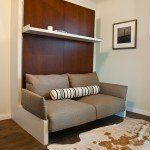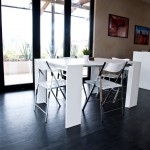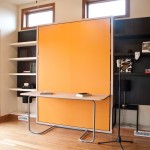Sustainable Luxury and the Solar Decathlon

Sustainable Luxury and the Solar Decathlon
By Challie Stillman
Photos by Laykin Photography
Embracing eco-living means abandoning luxury, right? Not exactly—think Tesla. In fact, as the interior design and architecture industries shift toward sustainability, the two are converging as one in the home and office. As reporter Jeremy Kahn puts it in The New York Times, “luxury often carries with it connotations of excess and waste.” More and more, this idea is far from reality. Designers, architects and homeowners are gravitating toward high-quality pieces that will last, rather than a high volume of trendy pieces that need replacing before long. Just like a quality little black dress that never goes out of style. This practice is self-evident in the fashion world where trends change with each new season. Sustainable luxury is not about how much of something you own, but rather a much more complicated equation: how each piece is made + the materials it is made from + the overall functionality it provides + how long the product will last + (and this is the wild card) how much you love it = the true measure of sustainability. This philosophy especially applies when furnishing interior spaces.
 The idea of “sustainable luxury” is apparent in the carefully designed and constructed homes at the U.S. Department of Energy Solar Decathlon. The competition challenges twenty collegiate teams to create self-sustaining, net-zero homes. The winning team will have found a way to best blend consumer appeal and design excellence with optimal energy efficiency and production. The challenge goes beyond a simple conceptualization—the teams must fully furnish the space to appeal to a real couple or family. The homes—from schools across the United States, Canada, and Europe—each overcome unique climates and challenges to create a complete living space.
The idea of “sustainable luxury” is apparent in the carefully designed and constructed homes at the U.S. Department of Energy Solar Decathlon. The competition challenges twenty collegiate teams to create self-sustaining, net-zero homes. The winning team will have found a way to best blend consumer appeal and design excellence with optimal energy efficiency and production. The challenge goes beyond a simple conceptualization—the teams must fully furnish the space to appeal to a real couple or family. The homes—from schools across the United States, Canada, and Europe—each overcome unique climates and challenges to create a complete living space.
 A perfect example of a well-executed design is the SHADE home, a collaboration between Arizona State University and the University of New Mexico. Designed with an active retired couple in mind, the team developed a housing concept that overcomes the environmental challenges of the American Southwest with low-impact features for occupants seeking to incorporate sustainability into their way of life. In an area with harsh conditions such as paved, heat-attracting streets and energy-sucking lawns, SHADE is quite a revolution. By designing the interior of the home to unite the beauty of the landscape and fluid, flexible interiors, the Solar Decathlon team has created a space that is as appealing as it is just plain smart.
A perfect example of a well-executed design is the SHADE home, a collaboration between Arizona State University and the University of New Mexico. Designed with an active retired couple in mind, the team developed a housing concept that overcomes the environmental challenges of the American Southwest with low-impact features for occupants seeking to incorporate sustainability into their way of life. In an area with harsh conditions such as paved, heat-attracting streets and energy-sucking lawns, SHADE is quite a revolution. By designing the interior of the home to unite the beauty of the landscape and fluid, flexible interiors, the Solar Decathlon team has created a space that is as appealing as it is just plain smart.

With an active retired couple in mind, the ease of use in the home is a critical component to the interior of the space. The 800-square-foot home celebrates equilibrium with the living environment. The home engages indoor and outdoor spaces
Rather than impulsively designing, the teams have opted to go the timeless and classic route—pieces that will be loved day in and day out for years. Using furniture that has more than one purpose—a library bookshelf that hides a queen bed, for instance—gives occupants multiple functions per piece and offer many possibilities on how to use the space. At the same time, high-end consumers are seeking to align their purchase habits with their sustainable values and lifestyles within their own home or office environment.

These include timelessness, durability, innovation and craftsmanship (the hallmark of luxury), as well as [sustainably?] forested wood products, water-based lacquers, no off-gassing of toxins, and recyclable materials—all characteristics that support the core objectives of sustainability and social responsibility.through the use of multiple patios that extend the living area of the home. The flexible space adapts instantaneously. Functionality of the home is maximized by high-quality transforming pieces that will last throughout the lifespan of the home. The flex space is a large living room that can be transformed into an office during the day and a bedroom at night. By providing versatility for the occupants, the space reaches maximum functionality potential. For instance, the dining room seats 12 guests by using the extending console table. Flexibility is the main goal of the interior design. High-quality furnishings and simple white palate result in a sense of luxury within the sustainable space.
 The goals of the Solar Decathlon are to support, promote and educate people about sustainable and efficient living solutions, both now and into the future. By challenging students across the globe to think critically about the way we live, this competition is providing up-and-coming designers, engineers and architects hands-on experience in designing our future—a luxurious and sustainable one.
The goals of the Solar Decathlon are to support, promote and educate people about sustainable and efficient living solutions, both now and into the future. By challenging students across the globe to think critically about the way we live, this competition is providing up-and-coming designers, engineers and architects hands-on experience in designing our future—a luxurious and sustainable one.

